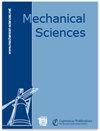纯回转关节静态平衡平面串联机械手的弹簧效率评估和弹簧方法的有效利用
IF 1.5
4区 工程技术
Q4 ENGINEERING, MECHANICAL
引用次数: 2
摘要
摘要提出了一种静力弹簧平衡平面串联机械臂的弹簧效率评估方法。过去已经确定了无辅助连杆平面串联机械臂静平衡所允许的弹簧构型。重力由弹簧结构系统平衡;然而,弹簧配置也包含弹簧之间的反向效应。从概念上讲,弹簧之间的反向效应更少,弹簧系统的负担更轻,这意味着弹簧的使用效率更高,因此,系统将更安全,其使用寿命将更长。在本研究中,弹簧能量以二次曲线形式表示。系数以二次形式表示弹性能随杆间相对位置的变化,称为“弹性拟刚度”。与重力能量的二次形式相比,静态平衡的弹性伪刚度被认为是弹簧的积极贡献,而那些包含反效应的被视为消极贡献。弹簧效率定义为弹性伪刚度与总弹性伪刚度之比,对平衡有正贡献。为了有效地使用弹簧,需要减少弹簧参数函数的反效应,包括弹簧刚度和弹簧在连杆上的附着位置。提出了一种通过调整弹簧参数来有效利用弹簧的方法。此外,还发现,对于连接在相邻连杆之间的弹簧,弹簧效率为100%,并且随着弹簧跨越的节点数量的增加,弹簧效率降低。在弹簧机械手系统中,效率与载荷呈负相关。最后以三自由度机械臂为例进行了效率评估。本文章由计算机程序翻译,如有差异,请以英文原文为准。
Spring efficiency assessment and efficient use of spring methods of statically balanced planar serial manipulators with revolute joints only
Abstract. This paper proposes a spring efficiency assessment of a statically
spring-balanced planar serial manipulator. The admissible spring configurations for the static balancing of planar serial manipulators without auxiliary links have been determined in the past. Gravity is balanced by the spring configuration systematically; however, the
spring configuration also contains counter-effects between springs.
Conceptually, with fewer counter-effects between springs, there is less
burden on the spring system, which means that the springs are used more
efficiently, and accordingly, the system would be safer, and its service life would be longer. In this study, the spring energy is represented in a
quadratic form. The coefficients in a quadratic form represent the change in elastic energy with the relative position between links, which is named
“elastic pseudo-stiffness”. Compared to the quadratic form of gravity
energy, those elastic pseudo-stiffnesses for static balancing are regarded
as positive contributions of a spring, while those that contain counter-effects are seen as negative ones. Spring efficiency is defined as the ratio of the elastic pseudo-stiffnesses, which has positive contributions for balancing to total elastic pseudo-stiffnesses. To use springs efficiently, the counter-effects, which are functions of spring parameters, need to be decreased, including spring stiffness and the attachment location of springs on links. A method to use spring efficiently by adjusting spring parameters is developed. Furthermore, it is found that, for a spring attached between adjacent links, the spring efficiency is 100 %, and the spring efficiency decreases while the number of joints over which the spring spans increases. In a spring manipulator system, the efficiency is negatively correlated to the payload. As an example, an efficiency assessment on a 3 degrees of freedom (DOF) manipulator is shown at the end.
求助全文
通过发布文献求助,成功后即可免费获取论文全文。
去求助
来源期刊

Mechanical Sciences
ENGINEERING, MECHANICAL-
CiteScore
2.20
自引率
7.10%
发文量
74
审稿时长
29 weeks
期刊介绍:
The journal Mechanical Sciences (MS) is an international forum for the dissemination of original contributions in the field of theoretical and applied mechanics. Its main ambition is to provide a platform for young researchers to build up a portfolio of high-quality peer-reviewed journal articles. To this end we employ an open-access publication model with moderate page charges, aiming for fast publication and great citation opportunities. A large board of reputable editors makes this possible. The journal will also publish special issues dealing with the current state of the art and future research directions in mechanical sciences. While in-depth research articles are preferred, review articles and short communications will also be considered. We intend and believe to provide a means of publication which complements established journals in the field.
 求助内容:
求助内容: 应助结果提醒方式:
应助结果提醒方式:


